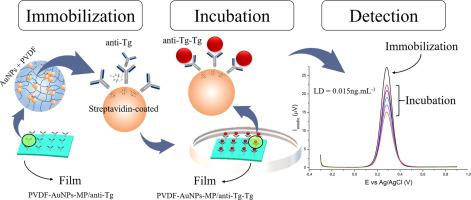Bioelectrochemistry ( IF 4.8 ) Pub Date : 2021-07-16 , DOI: 10.1016/j.bioelechem.2021.107888 Maria Oneide Silva de Moraes 1 , João de Deus Pereira de Moraes Segundo 2 , Marcos Marques da Silva Paula 3 , Maria Goreti Ferreira Sales 4 , Walter Ricardo Brito 5

|
The highly sensitive detection of serum thyroglobulin (Tg) is essential in the post-treatment follow-up of patients with differentiated thyroid cancer undergoing total or partial thyroidectomy and radioactive iodine ablation and requires sensitive, accurate and stable methods. This work proposes an electrochemical immunosensor for the detection of serum Tg antigen, making use of innovative nanocomposites including polyvinylidene fluoride (PVDF) microparticles coated with streptavidin (MP) and gold nanoparticles (AuNPs). The functionalized polymer matrices were characterized by UV–Vis, FTIR, XPS, SEM, dynamic light scattering, and free surface energy. Immobilization of biotin-labeled anti-thyroglobulin monoclonal antibodies was achieved by binding these to the polymer nanocomposite via streptavidin proteins. The analytical response was measured in quintuplicate and had a linear profile from 2.0 to 10.0 ng/mL Tg, with r2 of 0.985. The limits of detection and quantification were excellent, equal to 0.015 and 0.047 ng/mL, respectively. In addition, the recovery factor was equal to 95.4% (1.0 ng/mL Tg). Overall, the innovative polymer-based nanocomposite used herein enabled the production of an electrochemical-based immunosensor with excellent sensitivity, selectivity, and reproducibility. It evidenced the remarkable potential of determining low levels of Tg in in vitro assays, thereby suggesting that it may be considered for the analyzes of serum patients.
中文翻译:

用于人甲状腺球蛋白的蛋白质-聚偏二氟乙烯纳米复合材料的高灵敏度电化学免疫传感器
血清甲状腺球蛋白(Tg)的高灵敏度检测对于接受甲状腺全切除术或部分切除术和放射性碘消融术的分化型甲状腺癌患者的治疗后随访至关重要,需要灵敏、准确和稳定的方法。这项工作提出了一种用于检测血清 Tg 抗原的电化学免疫传感器,利用创新的纳米复合材料,包括涂有链霉亲和素 (MP) 和金纳米粒子 (AuNPs) 的聚偏二氟乙烯 (PVDF) 微粒。功能化的聚合物基质通过 UV-Vis、FTIR、XPS、SEM、动态光散射和自由表面能进行表征。生物素标记的抗甲状腺球蛋白单克隆抗体的固定化是通过链霉亲和素蛋白与聚合物纳米复合材料结合来实现的。0.985 中的2个。检测限和定量限非常好,分别等于 0.015 和 0.047 ng/mL。此外,回收率等于 95.4% (1.0 ng/mL Tg)。总体而言,本文使用的创新聚合物基纳米复合材料能够生产具有优异灵敏度、选择性和重现性的电化学免疫传感器。它证明了在体外测定中确定低水平 Tg 的显着潜力,从而表明可以考虑将其用于血清患者的分析。











































 京公网安备 11010802027423号
京公网安备 11010802027423号